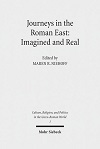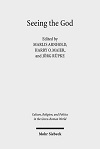|
|
|
Culture, Religion, and Politics in the Greco-Roman World
(CRPG) |
Culture, Religion, and Politics in the Greco-Roman World
Edited by Kendra Eshleman, Teresa Morgan, Laura Nasrallah, Maren R.
Niehoff, and Peter Van Nuffelen
Advisory Board: Milette Gaifman,
Martha Himmelfarb, Hayim Lapin, Duncan MacRae, Jörg Rüpke, Lieve Van
Hoof
The series responds to an increasing awareness among
scholars of the ancient Mediterranean world that phenomena of
culture, religion, and politics cannot be isolated, but must instead
be studied in relation to each other. Moreover, since the work of
the History of Religions School, it is clear that such phenomena
cross boundaries of languages, countries, and religions. To render a
truly fruitful examination of Greek literature in the Imperial
period, the time has come to acknowledge its deep entanglement in
Roman politics and to investigate parallels in contemporaneous
religious texts. The new series, launched by an international team
of experts with a strong interdisciplinary orientation, provides the
necessary platform for such pioneering research. Both Jewish and
Christian texts as well as those dealing with Greek and Roman
religion and philosophy will share the same standing. The series
also welcomes studies on other religions and their connections in
the Greco-Roman world.
ISSN: 2510-0785 - Suggested citation: CRPG |
|
Culture, Religion, and Politics in the
Greco-Roman World
Herausgegeben von Kendra Eshleman, Teresa
Morgan, Laura Nasrallah, Maren R. Niehoff und Peter Van Nuffelen
Advisory Board: Milette Gaifman, Martha Himmelfarb, Hayim Lapin,
Duncan MacRae, Jörg Rüpke, Lieve Van Hoof
Diese neue Buchreihe trägt dem wachsenden Bewusstsein von
Wissenschaftlern Rechnung, die sich mit antiken
Mittelmeerkulturen befassen, dass Kultur, Religion und Politik
nicht mehr isoliert betrachtet werden können, sondern nur in
ihren wechselseitigen Beziehungen. Außerdem ist, spätestens seit
der Arbeit der Religionsgeschichtlichen Schule, klar, dass
derlei Phänomene die Grenzen von Sprache, Ländern und Religionen
überschreiten. Um eine wirklich ertragreiche Untersuchung
griechischer Literatur in der Kaiserzeit leisten zu können, ist
es an der Zeit, ihre tiefgreifende Verwurzelung in römischer
Politik anzuerkennen und die Parallelen in zeitgenössischen
religiösen Texten zu untersuchen. Diese neue Reihe, die von
einem internationalen Team von Fachwissenschaftlern mit stark
interdisziplinärer Orientierung gegründet wurde, bietet die
notwendige Plattform für solche Pionierarbeiten. Sowohl
jüdischen als auch christlichen Texten sowie denen, die sich mit
griechischer und römischer Religion und Philosophie befassen,
wird dieselbe Bedeutung beigemessen. Die Reihe begrüßt auch
Studien zu anderen Religionen und deren Verbindung mit der
griechisch-römischen Welt.
ISSN: 2510-0785 - Zitiervorschlag: CRPG
|
 |
Maren R. Niehof
Journeys in the Roman East:
Imagined and Real
Mohr Siebeck, 2017, 440 Seiten, Cloth,
978-3-16-155111-6
159,00 EUR
 |
Culture, Religion, and Politics in the Greco-Roman World (CRPG)
2
[Reisen im Osten des Römischen Reichs: Fiktiv und Real.]
Published in English.
In the Roman Empire, travelling was
something of a central feature, facilitating commerce, pilgrimage,
study abroad, tourism, and ethnographic explorations. The present
volume investigates for the first time intellectual aspects of this
phenomenon by giving equal attention to pagan, Jewish, and Christian
perspectives. A team of experts from different fields argues that
journeys helped construct cultural identities and negotiate between
the local and the particular on the one hand, and wider imperial
discourses on the other. A special point of interest is the question
of how Rome engages the attention of intellectuals from the Greek
East and offers new opportunities of self-fashioning. Pagans, Jews,
and Christians shared similar experiences and constructed comparable
identities in dialogue, sometimes polemics, with each other. The
collection addresses the following themes: real and imagined
geography, reconstructing encounters in distant places, between the
bodily and the holy, Jesus' travels from different perspectives, and
destination Rome. The articles in each section are arranged in
chronological order, ranging from early imperial texts to rabbinic
and patristic literature.
Survey of contents
Maren Niehoff:
Journeys on the Way to This Volume
Imagined and Real Geography
Ewen Bowie: Eastern Mediterranean Travel: The View from Aphrodisias
and Hadrianoutherae – Janet Downie: The Romance of Imperial Travel
in Aelius Aristides' Smyrna Orations – Nicola Zwingmann: The Account
of a Journey in the Erôtes of [Pseudo-] Lucian in the Context of
Ancient Travel – Amit Gevaryahu: There and Back Again: A Journey to
Ashkelon and its Intertexts in Yerushalmi Sanhedrin 4:6 (=Hagigah
2:2) – Benjamin Isaac: Virtual Journeys in the Roman Near East: Maps
and Geographical Texts
Reconstructing Encounters in Distant
Places
Froma Zeitlin: Apodêmia: The Adventure of Travel in the
Greek Novel – Kendra Eshleman: Eastern Travel in Apollonius and the
Apocryphal Acts of Thomas – Maren Niehoff: Parodies of Educational
Journeys in Josephus, Justin Martyr and Lucian – Jonathan Price: The
Historiographical Vehicle of Lucian's Journey in Verae Historiae –
Catherine Hezser: Strangers on the Road: Otherness, Identification
and Disguise in Rabbinic Travel Tales of Late Roman Palestine
Between the Bodily and the Holy
Ian Rutherford: Concord and
Communitas: Greek Elements in Philo's Account of Jewish Pilgrimage –
Laura Nasrallah: Imposing Travelers. An Inscription from Galatia and
the Journeys of the Earliest Christians – Sarit Kattan Gribetz:
“Lead Me Forth in Peace”: The Wayfarer's Prayer and Rabbinic Rituals
of Travel in the Roman World – Georgia Frank: Touching and Feeling
in Late Antique Pilgrims' Narratives
Jesus' Travels from
Different Perspectives
Reinhard Feldmeier: The Wandering Jesus:
Luke's “Travel Narrative” – Richard Kalmin: Jesus' Descent to the
Underworld in the Babylonian Talmud and in Christian Literature of
the Roman East
Destination Rome
Daniel Schwartz: “Going up to
Rome” in Josephus' Antiquities – Knut Backhaus: From Disaster to
Disclosure: The Shipwreck in the Book of Acts in Light of
Greco-Roman Ideology – Yonatan Moss: “From Syria all the Way to
Rome:” Ignatius of Antioch's Pauline Journey to Christianity
Maren R. Niehoff Born 1963; studied Jewish Studies, Literature and
Philosophy in Berlin, Jerusalem and Oxford; 1989–91 Junior Fellow at
the Society of Fellows at Harvard University; currently Max Cooper
Professor of Jewish Thought at the Hebrew University of Jerusalem. |
 |
Harry O. Maier
Seeing the God
Image,
Space, Performance, and Vision in the Religion of the Roman Empire
Mohr Siebeck, 2018, 300 Seiten, Cloth, 978-3-16-155721-7
120,00 EUR

|
Culture, Religion, and Politics in the Greco-Roman World (CRPG)
1
Ed. by Marlis Arnhold, Harry O. Maier, and Jörg Rüpke
[Den
Gott sehen. Bildnis, Raum, Vorstellung und Vision in der Religion
des Römischen Reichs.]
Published in English.
The first
inter-disciplinary and cross-disciplinary work of its kind, this
book focuses on the importance of visual culture in the study of
classical, Roman, and Christian antiquity. It explores the role of
the visual in helping to create a vision of the gods and how
commitment to the visibility of the divine affected ancient
religious practices, rituals, and beliefs. The essays deploy a wide
range of disciplines that include archaeology, iconology, cultural
studies, visual anthropology, the study of ancient rhetoric, and the
cognitive sciences to consider the visual aspects of ancient
religion from a variety of angles. The contributors take up the role
of the visual in multiple contexts including domestic art, the
imperial cult, martyrology, ritual practice, and temples. This
groundbreaking book, which includes essays by classicists, Roman
historians, archaeologists, biblical scholars, and scholars of
ancient Christian iconography, promises to advance the discussion of
the importance and role of visual culture in shaping the religions
of antiquity in significant new ways.
Survey of contents
Introduction
Section 1: Forms of Imagining Divine Presences and
of Referring to Divine Agents
Steven J. Friesen: Material
Conditions for Seeing the Divine: The Temple of the Sebastoi at
Ephesos and the Vision of the Heavenly Throne in Revelation 4–5 –
Katharina Rieger: Imagining the Absent and Perceiving the Present:
An Interpretation of Material Remains of Divinities from the Rock
Sanctuary at Caesarea Philippi (Gaulantis) – Kristine Iara: Seeing
the Gods in Late Antique Rome – Jörg Rüpke: Not Gods Alone: on the
Visibility of Religion and Religious Specialists in Ancient Rome
Section 2: Modes of Image Creation and Appropriation of
Iconographies and Visual Cues
Richard L. Gordon: Getting it
Right: Performative Images in Greco-Egyptian Magical Practice –
Marlis Arnhold: Imagining Mithras in Light of Iconographic
Standardization and Individual Accentuation – Robin Jensen: The
Polymorphous Jesus in Early Christian Image and Text – David Balch:
Founders of Rome, of Athens, and of the Church: Romulus, Theseus,
and Jesus. Theseus and Ariadne with Athena Visually Represented in
Rome, Pompeii and Herculaneum
Section 3: Evocation of Specific
Images in People’s Minds
Harry O. Maier: Seeing the Blood of
God: The Triumphant Charade of Ignatius of Antioch the God-Bearer –
Annette Weissenrieder: Space and Vision of the Divine: The Temple
Imagery of the Epistle to the Ephesians – Brigitte Kahl: Citadel of
the God(s) or Satan’s Throne: The Image of the Divine at the Great
Altar of Pergamon between Ruler Religion and Apocalyptic
Counter-Vision – Vernon K. Robbins: Kinetic Divine Concepts, the
Baptist, and the Enfleshed Logos in the Prologue and Precreation
Storyline of the Fourth Gospel |
|

